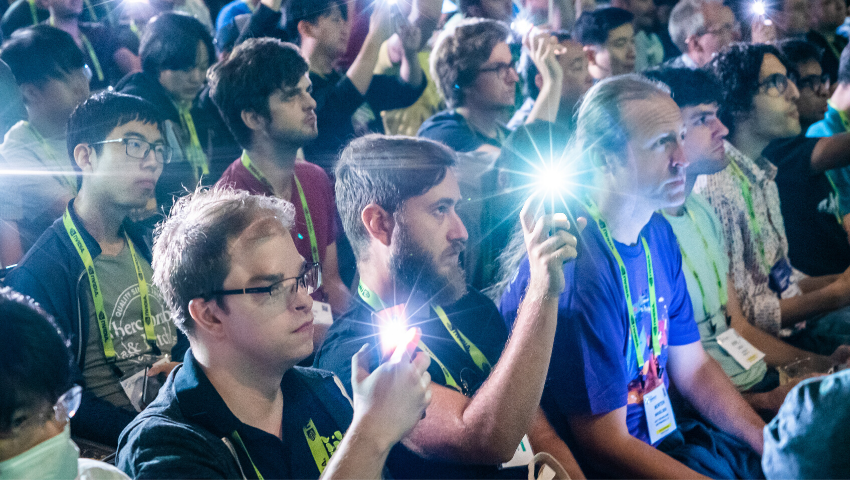Jim Hagarty © 2019 ACM SIGGRAPH
Real-Time Live! is hands-down one of the most exciting programs at the SIGGRAPH conference, and is consistently one of the most anticipated events in participants’ minds. So, what is Real-Time Live!, you ask?
Well, it started 12 years ago as part of the SIGGRAPH Computer Animation Festival Electronic Theater. The Electronic Theater has long been a night to celebrate the best in animated shorts and film production, but in 2008 it added four real-time demos. These were run live, without a net, on the Electronic Theater stage. It didn’t take long for Real-Time Live! to become its own event. Now, for two hours on Tuesday night during each subsequent conference, an audience of thousands gathers to watch a high-energy presentation of 10 real-time demos that are approximately six minutes each. These are the best in real-time content from the past year, as selected by a jury of experts. The 10 demos compete for two prestigious awards: the Audience Choice Award — voted live by those in attendance — and the Best in Show Award, which is determined by the Real-Time Live! jurors and is based on a combination of the submission material and the live component.
What Makes a Good Demo?
The basic requirement is that the demo involves real-time, interactive graphics, and
should be demoed live (with nothing pre-rendered or recorded). Other than that, demonstrations can run on desktop, mobile, game console, virtual reality, or web. Projects can span games, applications, creative tools, or research results, and should bring something unique artistically or technically. Since this is the first year that the conference will travel to Washington, D.C. (ever!), we are really hoping to share projects from military or government labs, who are doing amazing, interactive work that doesn’t typically make it to SIGGRAPH.
Many Real-Time Live! presentations show something that is technically new, but they also can show a creative and original use of existing technology that will be interesting and exciting for the audience. Previous Real-Time Live! presentations include both indie and AAA video games, a mobile medical training app, real-time pre-production tools, tools for game developers, integrations of ray-tracing technology into game engines, physics simulations, motion capture, live facial capture and animation, and many more.
Lifespan of a Demo
Let’s walk through the lifespan of a Real-Time Live! project.
It all starts with having something cool and exciting that you’d like to show. Is what you have appropriate? Just ask yourself two questions:
- Does it require real-time rendering?
- Could I demonstrate it live?
If the answers are both “yes,” you are on your way!
The next step is putting together your submission. This year, submissions are due by 7 April 2020. The main things you’ll need for your submission are a two-minute video, short biographies of identified presenters, a description of your submission, and a breakdown of how you’d spend your six minutes on stage. For game demonstrations that are also planning to be shown at GDC 2020 in March, you probably already have video to satisfy the submission criteria, so just tell us what you’ll be able to show by July and how it might be different.
Next, the jury steps in and, after submissions close, has a couple of weeks to review submitted demos before making final decisions in May. After demos are accepted, each selected project team will participate in a virtual rehearsal before conference to ensure that the demo promised will be ready. The rehearsal also allows each team to work out kinks and to confirm on-site technology needs.
Then, the fun really starts. On the Friday and Saturday before the conference, presenters load their equipment into the theater and begin on-site testing. Sunday morning is reserved for a full rehearsal in order to work out sequencing and to make sure all the audio and video is ready for Tuesday night.
Finally, we wait… until the main event! With everything ready to go, conference-goers file in during a pre-show, the lights dim, and the first presentation begins. After the highs and lows of the live show, the audience and jury make final selections for the night’s awards and, with tensions high, winners are announced.
That just about encompasses the journey of a Real-Time Live! presenter, from inception through presentation on the SIGGRAPH stage. Be a part of the action and share your submission now through 7 April!
 Marc Olano is an associate professor in University of Maryland, Baltimore County’s Department of Computer Science and Electrical Engineering. He is also the SIGGRAPH 2020 Real-Time Live! Chair.
Marc Olano is an associate professor in University of Maryland, Baltimore County’s Department of Computer Science and Electrical Engineering. He is also the SIGGRAPH 2020 Real-Time Live! Chair.



